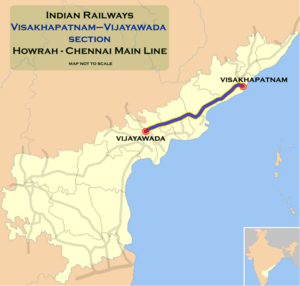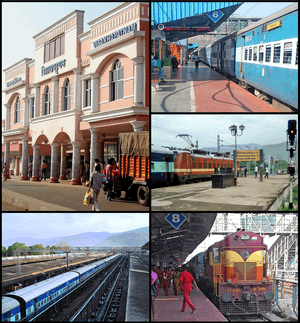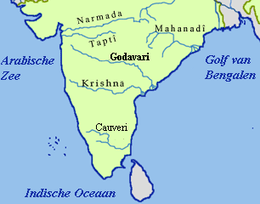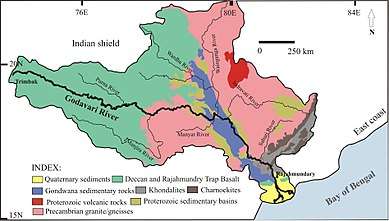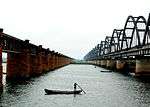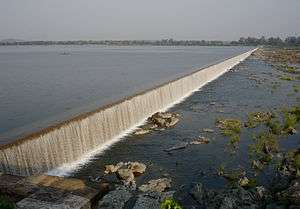Duvvada–Vijayawada section
The Duvvada–Vijayawada section (also known as Visakhapatnam-Vijayawada line) is a railway line connecting Duvvada of Visakhapatnam and Vijayawada, both in the Indian state of Andhra Pradesh.[1] The main line is part of the Howrah-Chennai main line.[2][3] The track from Duvvada to Thadi is under the administrative jurisdiction of South Coast Railway, and the rest of the line from Anakapalle to Vijayawada is under the administrative jurisdiction of South Coast Railway zone headquartered in Visakhapatnam.
| Duvvada–Vijayawada section | |||
|---|---|---|---|
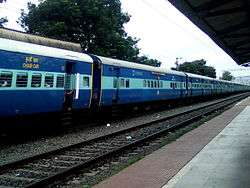 Ratnachal Express is one of the fastest and prestigious trains on Duvvada–Vijayawada section | |||
| Overview | |||
| Status | Operational | ||
| Locale | Andhra Pradesh | ||
| Termini | Duvvada Vijayawada | ||
| Operation | |||
| Opened | 1897 | ||
| Owner | Indian Railway | ||
| Operator(s) | South Coast Railway | ||
| Technical | |||
| Track length | 350 km (217 mi) | ||
| Number of tracks | 2 | ||
| Track gauge | 1,676 mm (5 ft 6 in) Broad gauge | ||
| Operating speed | up to 130 km/h (81 mph) | ||
| |||
Visakhapatnam–Vijayawada section | |||||||||||||||||||||||||||||||||||||||||||||||||||||||||||||||||||||||||||||||||||||||||||||||||||||||||||||||||||||||||||||||||||||||||||||||||||||||||||||||||||||||||||||||||||||||||||||||||||||||||||||||||||||||||||||||||||||||||||||||||||||||||||||||||||||||||||||||||||||||||||||||||||||||||||||||||||||||||||||||||||||||||||||||||||||||||||||||||||||||||||||||||||||||||||||||||||||||||||||||||||||||||||||||||||||||||||||||||||||||||||||||||||||||||||||||||||||||||||||||||||||||||||||||||||||||||||||||||||||||||||||||||||||||||||||||||||||||||||||||||||||||||||||||||||||||||||||||||||||||||||||||||||||||||||||||||||||||||||||||||||||||||||||||||||||||||||||||||||||||||||||||||||||||||||||||||||||||||||||||||||||||||||||||||||||||||||||||||||||||||||||||||||||||||||||||||||||||||||||||||||||||||||||||||||||||||||||||||||||||||||||||||||||||||||||||||||||||||||||||||||||||||||||||||||||||||||||||||||||||||||||||||||||||||||||||||||||||||||||||||||||||||||||||||||||||||||||||||||||||
|---|---|---|---|---|---|---|---|---|---|---|---|---|---|---|---|---|---|---|---|---|---|---|---|---|---|---|---|---|---|---|---|---|---|---|---|---|---|---|---|---|---|---|---|---|---|---|---|---|---|---|---|---|---|---|---|---|---|---|---|---|---|---|---|---|---|---|---|---|---|---|---|---|---|---|---|---|---|---|---|---|---|---|---|---|---|---|---|---|---|---|---|---|---|---|---|---|---|---|---|---|---|---|---|---|---|---|---|---|---|---|---|---|---|---|---|---|---|---|---|---|---|---|---|---|---|---|---|---|---|---|---|---|---|---|---|---|---|---|---|---|---|---|---|---|---|---|---|---|---|---|---|---|---|---|---|---|---|---|---|---|---|---|---|---|---|---|---|---|---|---|---|---|---|---|---|---|---|---|---|---|---|---|---|---|---|---|---|---|---|---|---|---|---|---|---|---|---|---|---|---|---|---|---|---|---|---|---|---|---|---|---|---|---|---|---|---|---|---|---|---|---|---|---|---|---|---|---|---|---|---|---|---|---|---|---|---|---|---|---|---|---|---|---|---|---|---|---|---|---|---|---|---|---|---|---|---|---|---|---|---|---|---|---|---|---|---|---|---|---|---|---|---|---|---|---|---|---|---|---|---|---|---|---|---|---|---|---|---|---|---|---|---|---|---|---|---|---|---|---|---|---|---|---|---|---|---|---|---|---|---|---|---|---|---|---|---|---|---|---|---|---|---|---|---|---|---|---|---|---|---|---|---|---|---|---|---|---|---|---|---|---|---|---|---|---|---|---|---|---|---|---|---|---|---|---|---|---|---|---|---|---|---|---|---|---|---|---|---|---|---|---|---|---|---|---|---|---|---|---|---|---|---|---|---|---|---|---|---|---|---|---|---|---|---|---|---|---|---|---|---|---|---|---|---|---|---|---|---|---|---|---|---|---|---|---|---|---|---|---|---|---|---|---|---|---|---|---|---|---|---|---|---|---|---|---|---|---|---|---|---|---|---|---|---|---|---|---|---|---|---|---|---|---|---|---|---|---|---|---|---|---|---|---|---|---|---|---|---|---|---|---|---|---|---|---|---|---|---|---|---|---|---|---|---|---|---|---|---|---|---|---|---|---|---|---|---|---|---|---|---|---|---|---|---|---|---|---|---|---|---|---|---|---|---|---|---|---|---|---|---|---|---|---|---|---|---|---|---|---|---|---|---|---|---|---|---|---|---|---|---|---|---|---|---|---|---|---|---|---|---|---|---|---|---|---|---|---|---|---|---|---|---|---|---|---|---|---|---|---|---|---|---|---|---|---|---|---|---|---|---|---|---|---|---|---|---|---|---|---|---|---|---|---|---|---|---|---|---|---|---|---|---|---|---|---|---|---|---|---|---|---|---|---|---|---|---|---|---|---|---|---|---|---|---|---|---|---|---|---|---|---|---|---|---|---|---|---|---|---|---|---|---|---|---|---|---|---|---|---|---|---|---|---|---|---|---|---|---|---|---|---|---|---|---|---|---|---|---|---|---|---|---|---|---|---|---|---|---|---|---|---|---|---|---|---|---|---|---|---|---|---|---|---|---|---|---|---|---|---|---|---|---|---|---|---|---|---|---|---|---|---|---|---|---|---|---|---|---|---|---|---|---|---|---|---|---|---|---|---|---|---|---|---|---|---|---|---|---|---|---|---|---|---|---|---|---|---|---|---|---|---|---|---|---|---|---|---|---|---|---|---|---|---|---|---|---|---|---|---|---|---|---|---|---|---|---|---|---|---|---|---|---|---|---|---|---|---|---|---|---|---|---|---|---|---|---|---|---|---|---|---|---|---|---|---|---|---|---|---|---|---|---|---|---|---|---|---|---|---|---|---|---|---|---|---|---|---|---|---|---|---|---|---|---|---|---|---|---|---|---|---|---|---|---|---|---|---|---|---|---|---|---|---|---|---|---|---|---|---|---|---|---|---|---|---|---|---|---|---|---|---|---|---|---|---|---|---|---|---|---|---|---|---|---|---|---|---|---|---|---|---|---|---|---|---|---|---|---|---|---|---|---|---|---|---|---|---|---|---|---|---|---|---|---|---|---|---|---|---|---|---|---|---|---|---|---|---|---|---|---|---|---|---|---|---|---|---|---|---|---|---|---|---|---|---|---|---|---|---|---|---|---|---|---|---|---|---|---|---|---|---|---|---|---|---|---|---|---|---|---|---|---|---|---|---|---|---|---|---|---|---|---|---|---|---|---|---|---|---|---|---|---|---|---|---|---|---|---|---|
| |||||||||||||||||||||||||||||||||||||||||||||||||||||||||||||||||||||||||||||||||||||||||||||||||||||||||||||||||||||||||||||||||||||||||||||||||||||||||||||||||||||||||||||||||||||||||||||||||||||||||||||||||||||||||||||||||||||||||||||||||||||||||||||||||||||||||||||||||||||||||||||||||||||||||||||||||||||||||||||||||||||||||||||||||||||||||||||||||||||||||||||||||||||||||||||||||||||||||||||||||||||||||||||||||||||||||||||||||||||||||||||||||||||||||||||||||||||||||||||||||||||||||||||||||||||||||||||||||||||||||||||||||||||||||||||||||||||||||||||||||||||||||||||||||||||||||||||||||||||||||||||||||||||||||||||||||||||||||||||||||||||||||||||||||||||||||||||||||||||||||||||||||||||||||||||||||||||||||||||||||||||||||||||||||||||||||||||||||||||||||||||||||||||||||||||||||||||||||||||||||||||||||||||||||||||||||||||||||||||||||||||||||||||||||||||||||||||||||||||||||||||||||||||||||||||||||||||||||||||||||||||||||||||||||||||||||||||||||||||||||||||||||||||||||||||||||||||||||||||||
History
Some years before passenger railways started functioning in India railway lines were laid for carrying construction materials. Amongst these were a line used for construction of the Solani aqueduct over the Ganges Canal near Roorkee in the 1830s, the Red Hill Railroad in 1837 used for construction of a canal near Chennai, and the Godavari Dam Construction Railway used for transporting materials for the construction of the Dowlaisweram Anicut at Rajahmundry around 1845. The project was completed in 1852 and the railway was closed down.[4]
The Red Hill Railroad near Chennai, used in 1837 for transporting granite, is considered by many as the first operational railway in India. Madras Railway was incorporated in 1853 the Great Southern Railway of India was formed in 1858.[5] The Great Southern Railway of India was merged with the Carnatic Railway in 1872 and renamed South Indian Railways in 1874. The main eastward route of Southern Mahratta Railway connected with other routes till Vijayawada (then known as Bezwada) in 1888. The mainline of Nizam's Guaranteed State Railway was extended to Vijayawada in 1889.[6]
During the period 1893 to 1896, 1,287 km (800 mi) of the East Coast State Railway, from Vijayawada to Cuttack was built and opened to traffic.[7][8] The construction of the Old Godavari Bridge in 1897[6] and construction of the Vijayawada-Madras link in 1899 enabled the through running of trains.[6]
The southern part of the East Coast State Railway (from Waltair to Vijayawada) was taken over by Madras Railway in 1901.[9]
Railway reorganization
In the early 1950s legislation was passed authorizing the central government to take over independent railway systems that were there. On 14 April 1951 the Madras and Southern Mahratta Railway, the South Indian Railway Company and Mysore State Railway were merged to form Southern Railway. Subsequently, Nizam's Guaranteed State Railway was also merged into Southern Railway. On 2 October 1966, the Secunderabad, Solapur, Hubli and Vijayawada Divisions, covering the former territories of Nizam’s Guaranteed State Railway and certain portions of Madras and Southern Mahratta Railway were separated from Southern Railway to form the South Central Railway . In 1977, Guntakal division of Southern Railway was transferred to South Coast Railway and the Solapur division transferred to Central Railway. Amongst the seven new zones created in 2010 was South Western Railway, which was carved out of Southern Railway.[10] In 2019 it was moved to South Coast Railway zone.
Stations
- Eluru
- Bhimadolu
- Duvvada
- Anakapalle
- Kasimkota
- Bayyavaram
- Narasingapalli
- Elamanchili
- Regupalem
- Narsipatnam Road
- Gullipadu
- Tuni
- Hamsavaram
- Timmapuram
- Annavaram
- Ravikampadu
- Durgada Gate
- Gollaprolu
- Pithapuram
- Samalkot Junction
- Gudaparti
- Medapadu
- Pedabramadvam (alternatively Peddabrahmadevam)[11]
- Bikkavolu
- Balabhadrapuram
- Anaparti
- Anaparti
- Dwarapudi
- Kesavaram
- Kadiyam
- Rajahmundry
- Marripalem[12]
- Simhachalam
- Pendurthi (alternatively Pendurti)[13]
- Peda Avutapalle
- Gunadala
- Vijayawada
- Tadepalligudem
Electrification
Howrah-Chennai Mail was the first train in South Eastern Railway to be hauled by a diesel engine (WDM-1) in 1965.[14]
Speed limits
The entire Kharagpur-Duvvada-Vijayawada main line is classified as a "Group B" line which can take speeds up to 130 km/h. On the branch lines the speed limit is 100 km/hr.[15]
Passenger movement
Eluru, Rajahmundry and Vijayawada, on this line, are amongst the top hundred booking stations of Indian Railway.[16]
References
- "Surveys" (PDF). South Central Railway, Indian Railways. 24 July 2015. p. 14. Retrieved 3 May 2019.
- "RPF rededicates itself to passenger safety". The Hans India. 2 September 2015. Retrieved 26 March 2016.
- "3rd rail line joining Duvvada, Gudur to be completed in 5 yrs". The Business Standard. Vijayawada. 3 November 2015. Retrieved 26 March 2016.
- Darvill, Simon. "India's first railways". Godavari Dam Construction Railway. IRFCA. Retrieved 19 January 2013.
- "IR History – Early days". 1832–1869. IRFCA. Retrieved 19 January 2013.
- "IR History:Early days II". 1870–1899. IRFCA. Retrieved 19 January 2013.
- "Major Events in the Formation of S.E. Railway". South Eastern Railway. Archived from the original on 1 April 2013. Retrieved 2013-01-02.
- "History of Waltair Division". Mannanna.com. Archived from the original on 11 October 2012. Retrieved 2 January 2013.
- "IR History: Part III (1900–1947)". IRFCA. Retrieved 19 January 2013.
- "Geography – Railway Zones". IRFCA. Retrieved 23 January 2013.
- "PBD/Peddabrahmadevam". Indiarailinfo. Retrieved 12 February 2019.
- "Arrivals at MIPM/Marripalem". Indiarailinfo. Retrieved 12 February 2019.
- "Departures from PDT/Pendurti". Indiarailinfo. Retrieved 12 February 2019.
- "IR History: Part – IV (1947–1970)". IRFCA. Retrieved 21 November 2012.
- "Chapter II – The Maintenance of Permanent Way". Archived from the original on 3 December 2013. Retrieved 2013-01-02.
- "Indian Railways Passenger Reservation Enquiry". Availability in trains for Top 100 Booking Stations of Indian Railways. IRFCA. Archived from the original on 10 May 2014. Retrieved 2012-12-30.
